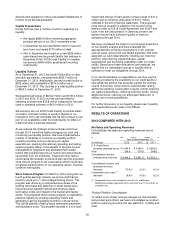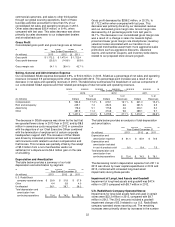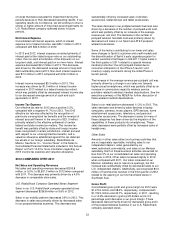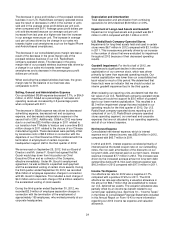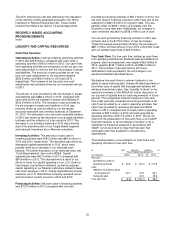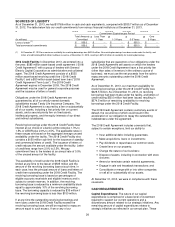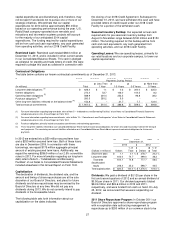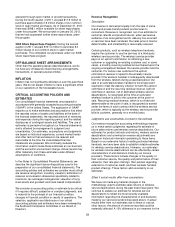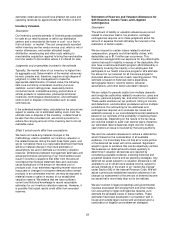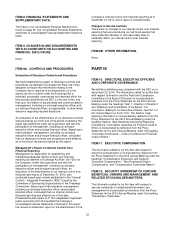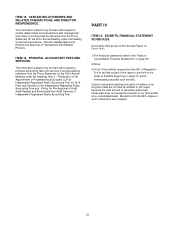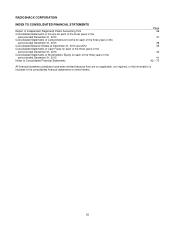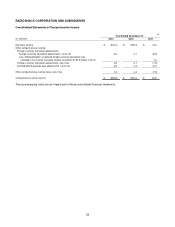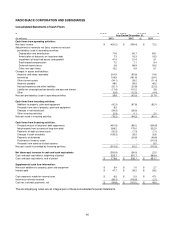Radio Shack 2013 Annual Report Download - page 32
Download and view the complete annual report
Please find page 32 of the 2013 Radio Shack annual report below. You can navigate through the pages in the report by either clicking on the pages listed below, or by using the keyword search tool below to find specific information within the annual report.30
Judgments and uncertainties involved in the estimate
Our liabilities for insurance, tax and legal contingencies
contain uncertainties because we are required to make
assumptions and to apply judgment to estimate the
exposures associated with these items. We use our history
and experience, as well as the specific circumstances
surrounding these claims, in evaluating the amount of
liability we should record. As additional information
becomes available, we assess the potential liability related
to our various claims and revise our estimates as
appropriate. These revisions could materially affect our
results of operations and financial position or liquidity.
Effect if actual results differ from assumptions
We have not made any material changes in the
methodology used to estimate our insurance, tax, or legal
contingencies reserves during the past three fiscal years,
and we do not believe there is a reasonable likelihood that
there will be a material change in the future estimates or
assumptions for these items. However, a 10% change in
our insurance reserves at December 31, 2013, would have
affected net income by approximately $4.0 million. As of
December 31, 2013, actual losses had not exceeded our
estimates. Additionally, for claims that exceed our
deductible amount, we record a gross liability and
corresponding receivable representing expected
recoveries, since we are not legally relieved of our
obligation to the claimant.
Although we believe that our insurance, tax and legal
reserves are based on reasonable judgments and
estimates, actual results could differ, which may expose us
to material gains or losses in future periods. These actual
results could materially affect our effective tax rate,
earnings, deferred tax balances and cash flows in the
period of resolution.
Valuation of Long-Lived Assets and Goodwill
Description
Long-lived assets, such as property and equipment, are
reviewed for impairment when events or changes in
circumstances indicate that the carrying amount may not be
recoverable, such as insufficient cash flows or plans to
dispose of or sell long-lived assets before the end of their
previously estimated useful lives. The carrying amount is
considered not recoverable if it exceeds the sum of the
undiscounted cash flows expected to result from the use
and eventual disposition of the asset. If the carrying amount
is not recoverable, we recognize an impairment loss equal
to the amount by which the carrying amount exceeds fair
value. We estimate fair value based on projected future
discounted cash flows. Impairment losses, if any, are
recorded in the period in which the impairment occurs. The
carrying value of the asset is adjusted to the new carrying
value, and any subsequent increases in fair value are not
recorded. Additionally, if it is determined that the estimated
remaining useful life of the asset should be decreased, the
periodic depreciation expense is adjusted based on the
new existing carrying value of the asset and the new
remaining useful life. Our policy is to evaluate long-lived
assets for impairment at a store level for retail operations.
We have acquired goodwill related to business acquisitions.
Goodwill represents the excess of the purchase price over
the fair value of net assets acquired. We review our
goodwill balances on an annual basis, during the fourth
quarter, and whenever events or changes in circumstances
indicate the carrying value of a reporting unit might exceed
its fair value. If the carrying amount of a reporting unit
exceeds its fair value, we recognize an impairment loss for
this difference.
Judgments and uncertainties involved in the estimate
Our impairment loss calculations for long-lived assets
contain uncertainties because they require us to apply
judgment and estimates concerning future cash flows,
strategic plans, useful lives and assumptions about market
performance. We also apply judgment in the selection of a
discount rate that reflects the risk inherent in our current
business model.
Our impairment loss calculations for goodwill contain
uncertainties because they require us to estimate fair
values of our reporting units. We estimate fair values based
on various valuation techniques such as discounted cash
flows and comparable market analyses. These types of
analyses contain uncertainties because they require us to
make judgments and assumptions regarding future
profitability, industry factors, planned strategic initiatives,
discount rates and other factors.
Effect if actual results differ from assumptions
We have not made any material changes in the accounting
methodologies we use to assess impairment loss for long-
lived assets or goodwill during the past three fiscal years,
and we do not believe there is a reasonable likelihood that
there will be a material change in the estimates or
assumptions we use in calculating goodwill impairment. If
actual results or performance of certain business units are
not consistent with our estimates and assumptions, we may
be exposed to additional impairment charges, which could
be material to our results of operations. For example, if the
profitability of our U.S. RadioShack company-operated
stores segment does not increase from our 2013 level,
there could be a material increase in the impairment of
long-lived assets at certain of our U.S. RadioShack
company-operated stores in future periods. Also, if the
actual results or performance of our Mexican subsidiary are
not consistent with our projections, estimates and
assumptions, there could be additional goodwill impairment
charges in future periods.
The total value of our goodwill at December 31, 2013, was
$12.7 million. Of this amount, $12.2 million related to
goodwill from the purchase of RadioShack de Mexico after
an impairment charge of $23.7 million in the fourth quarter
of 2013.
We did a multi-year projection based upon our normal
annual planning process for the upcoming year during the
fourth quarter of 2013. Due to the less than anticipated
operating results of the Mexican subsidiary in the fourth
quarter of 2013 and a review of operations in our normal
planning process for the upcoming year, the projected
operating results of our Mexican subsidiary for 2014 were
reduced and the timing of a planned expansion was


